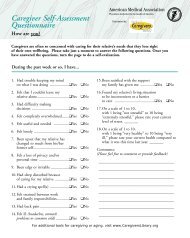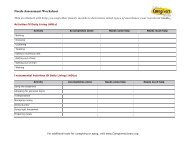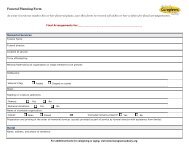MILES AWAY: - National Alliance for Caregiving
MILES AWAY: - National Alliance for Caregiving
MILES AWAY: - National Alliance for Caregiving
Create successful ePaper yourself
Turn your PDF publications into a flip-book with our unique Google optimized e-Paper software.
One interesting finding is that paid helpers were<br />
most important to those long-distance caregivers<br />
who reported that they were the only ones doing<br />
the caregiving. This small percentage of respondents<br />
(5%) were more likely to report using paid<br />
help than from any other category. For this group,<br />
if a family member was involved in helping them,<br />
it was most likely their own spouse rather than a<br />
sibling or relative who lived near the care recipient.<br />
Nearly half (46%) of the respondents reported<br />
spending time arranging <strong>for</strong> needed services <strong>for</strong><br />
the care recipient and/or monitoring or checking<br />
on the care being received (49%). On average,<br />
they spent 3.4 hours per week arranging services<br />
and another 4 hours per week checking on the<br />
person or monitoring care. Nearly three-quarters<br />
(72%) reported that they provide help with<br />
Instrumental Activities of Daily Living—such as<br />
transportation, grocery shopping, cooking, housework,<br />
managing finances, or managing medications—<strong>for</strong><br />
an average of 22 hours per month.<br />
Nearly 40% also reported that they provide some<br />
help with the more intense personal care activities—bathing,<br />
dressing, feeding, toileting—<strong>for</strong> an<br />
average of 12 hours per month.<br />
The most difficult part of caring <strong>for</strong> someone is<br />
making time to go see them and spend quality<br />
time with them. Expense is not just a plane<br />
ticket, it’s also lost work time.<br />
Financial Contribution of<br />
Long-Distance Caregivers<br />
Long-distance caregivers have substantial financial<br />
costs associated with their care. These caregivers<br />
say they spend an average of $193 per month<br />
on out-of-pocket purchases and services <strong>for</strong> the<br />
care recipient. In addition, they report spending<br />
another $199 per month in traveling and longdistance<br />
phone expenses associated with their<br />
distance from their relative, <strong>for</strong> a total of $392 per<br />
month.<br />
The total out-of-pocket expenses associated with<br />
caregiving (both travel and direct expenses) varies<br />
by distance. Those caregivers who live between 1<br />
and 3 hours from the care recipient report spending<br />
an average of $386 per month; those who live<br />
more than 3 hours away report a monthly expenditure<br />
of $674.<br />
For the relatively small group of respondents<br />
(nearly 10%) who also paid <strong>for</strong> services the care<br />
recipient needed, women reported spending on average<br />
$751 a month compaired to men who spend<br />
an average of $490 a month, meaning most family<br />
members take on the burden themselves.<br />
Table 5 illustrates the cost categories <strong>for</strong> out-ofpocket<br />
purchases <strong>for</strong> the care recipient and the<br />
average amount spent each month.<br />
Table 5. Specific Types of Monthly Expenses by<br />
Percent of Caregivers Providing Them<br />
% of Caregivers<br />
Providing<br />
Average Monthly<br />
Amount<br />
Medical Supplies<br />
Meals<br />
Pharmaceuticals<br />
Home Maintenance/Upkeep<br />
Cash to Pay their Bills<br />
14%<br />
31%<br />
13%<br />
20%<br />
17%<br />
$97<br />
$63<br />
$175<br />
$145<br />
$455<br />
8









